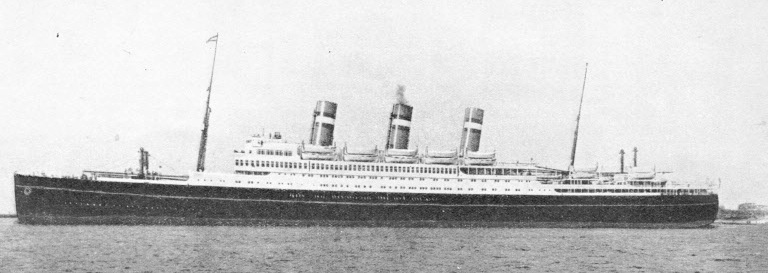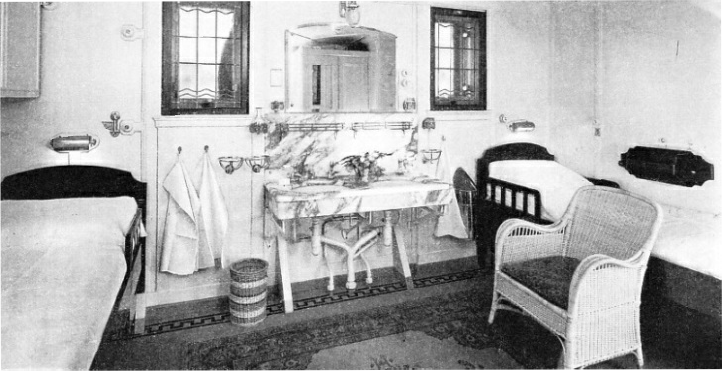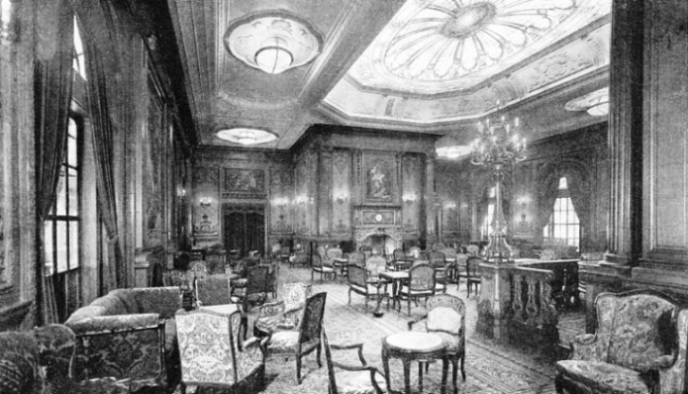

© Shipping Wonders of the World 2012-

The “Statendam”
Flagship of the Holland-

BUILT AT BELFAST and fitted out in Holland, the Statendam has a gross tonnage of 28,291. Her length is 674 ft 3 in, her beam 81 ft 4 in and her depth 49 ft 5 in. She is propelled by twin screws operated by geared turbines taking steam from water tube boilers. She carries 1,670 passengers in addition to a crew of 600. Her speed is 19 knots.
TIDY towns, clean beautiful meadows, spotless kitchens -
The Statendam, built in 1929, is the third ship to bear the name. The first was a comparatively small ship of 10,000 tons built for the Holland-
The ship did not sink. She maintained her trim but settled a bit lower in the water. Attendant tugs took her in charge and set course for Lough Swilly. The attacker had escaped, but on the following day another submarine, UB 124, motored right in between the screening warships and torpedoed the Justicia twice amidships. Even British shipbuilding was not proof against four torpedoes, and the stricken vessel sank by the stern. For hours on end the destroyers hunted UB 124 and at last they succeeded in getting her.
With the grim happenings of war left behind, the Holland-
The Statendam is 674 ft 3-
Careful consideration has been given in the Statendam to the problems of lighting and ventilation. The electric generating installation supplies current to some 9,000 lights in addition to electric motors and heaters, and in the ship there are about 2,000,000 feet of electric cable.
The ventilating system is operated by seventy-
rooms measure 27 feet by 17 feet and each of them has five windows. It is said that, for her size, the Statendam is provided with more windows than any other ship afloat. In the superstructure the circular port-
The technical details of this ship’s design and appointments are, however, overshadowed, in the opinion of most travellers, by the magnificence of her interior decorations. Since the Middle Ages Dutch interiors have held high positions in art and painting, and the Statendam’s public rooms typify the best that decorative skill can produce. Right forward, extending the whole width of the ship and surmounted only by the navigating bridge and the chart-
The style of decoration adopted for this room is Chinese, with red lacquer predominating. The floor is tiled with rubber and covered with beautiful Chinese rugs. The furnishings include chairs and settees with little tables placed conveniently here and there for the refreshment necessary to the proper contemplation of an unlimited expanse of salt water. Abaft the Palm Court the traveller finds the boat deck, flanked by the great lifeboats, and providing facilities for the ever-

A CABIN-
On the promenade deck too is the great lounge, domed over in the centre with multi-
The after vestibule, leading into the smoking room, is panelled in dark mahogany and, with its concealed lighting, old-
and numerous staircases are also provided. The main stairway leads down to a spacious entrance hall, splendidly decorated and lined with marble.
The most spacious room in the Statendam is the magnificent dining saloon, which occupies the entire middle portion of the ship on the third deck, or C Deck. This saloon is decorated and furnished in the Louis XVI style and during the day it is sunlit through large oval sidelights. At night an ingenious system of lighting concealed behind coloured glass throws a glow of light over the whole scene.
Two fine oil paintings, representing “The Material and Spiritual Harvests of Mankind”, by a famous Dutch artist, the late W. L. Bruckman, comprise the principal decorations of the dining saloon. There are, in addition, a number of small oil murals which, with the ceiling paintings, were carried out by another Dutch artist, H. van der Velde.
Cruises from New York
The swimming pool is one feature that now seems to be essential in a modern liner. The pool in the Statendam is situated on F Deck and has been made the subject of a magnificent display of tiling. The colouring is blue and the tiles are of the world-
The passenger accommodation is in keeping with the public rooms, with well-
The tourist smoking room on B Deck leads out on to a promenade and to a spacious games area extending the entire width of the ship. On A Deck is the tourist veranda cafe, fitted with large sliding windows that provide a clear view on three sides. The decorations of the cafe, in light-
The principal service of the Statendam, as the name of her owners suggests, is between Holland and America. She sails from Rotterdam, and usually calls at Boulogne and Southampton on her way to New York. The Statendam was scheduled to begin her maiden voyage on April 11, 1929, and her arrival in New York coincided with the three hundredth anniversary of the arrival of the first Dutch ship in America. It was Henry Hudson’s Half Moon (D’Halve Maen) sailing into the same waters that led to the first settlement on the site of what is now New York City.
It is not merely on the Atlantic service, however, that the Statendam has made her reputation. Many a fine cruise in historic Waters stands to her credit. Holland-
The Mediterranean cruises, however, offer the greatest variety of scene. The ship, having left New York on a bitterly cold afternoon early in February, steams steadily east for seven days to Funchal, Madeira.
Two days later the ship reaches the gateway of the Mediterranean, the Rock of Gibraltar, with its mighty fortress and gun galleries. Tangier in Morocco provides another opportunity to land and see at first hand the motley crowds that throng this North African port. Algiers, capital of Algeria, is reached under a blazing sun, just a fortnight after the ship has left wintry New York.
Another two days and the steamer anchors off Monaco. The next stay is at Malta. The Statendam now skirts the coast of Asia Minor, bound for Beirut, the chief city of Syria, set among the cedars of Lebanon from which Solomon took timbers for his Temple. The steamer enters St. George’s Bay -
Mediterranean Ports of Call
Next the ship sails to the cradle of civilization -
After nearly a week in Egyptian waters the Statendam steams northwest to the famous island of Rhodes, passing Crete, with the towering peak of Mount Ida.
Next the liner steams through the Dardanelles, past Gallipoli, to the ancient city of the Emperor Constantine -
Athens is the next port of call. Then the ship steams along the coast of Illyria, where sailed Ulysses, to Corfu, a wonderful haven of natural beauty. At Kotor, once called Cattaro, on the Adriatic, the coast-
Along the Dalmatian coast the voyage continues to Dubrovnik, once known as Ragusa, and then, after a brief stay, to Venice. From Venice the return voyage is made down the Adriatic, round the “heel” of Italy, to anchor in the busy harbour of Messina, scene of the great earthquake of December 1908.
Early on a March morning the Statendam anchors in one of the most famous roadsteads in the world, the Bay of Naples. Cannes is the last call in the Mediterranean, and after having called at Southampton to disembark passengers for London, the Statendam steams on to her home port of Rotterdam. One week later the travellers arrive in New York, exactly two months after having set out on the long journey to the show -

THE LOUNGE ON THE PROMENADE DECK. In this magnificent apartment most of the social life of the ship is centred. The skylight, with its multi-
You can read more on “Dutch Shipping”, “Holland’s Inland Ports” and “The Ophir” on this website.